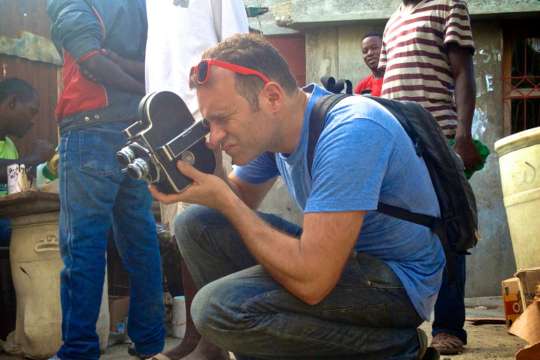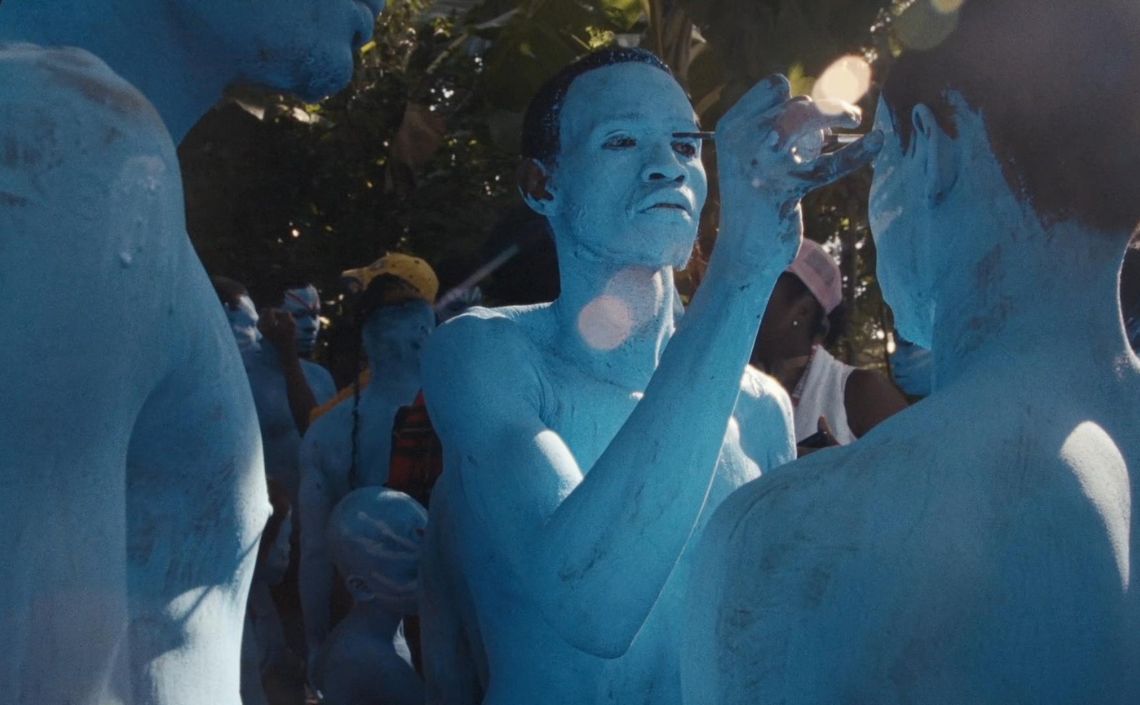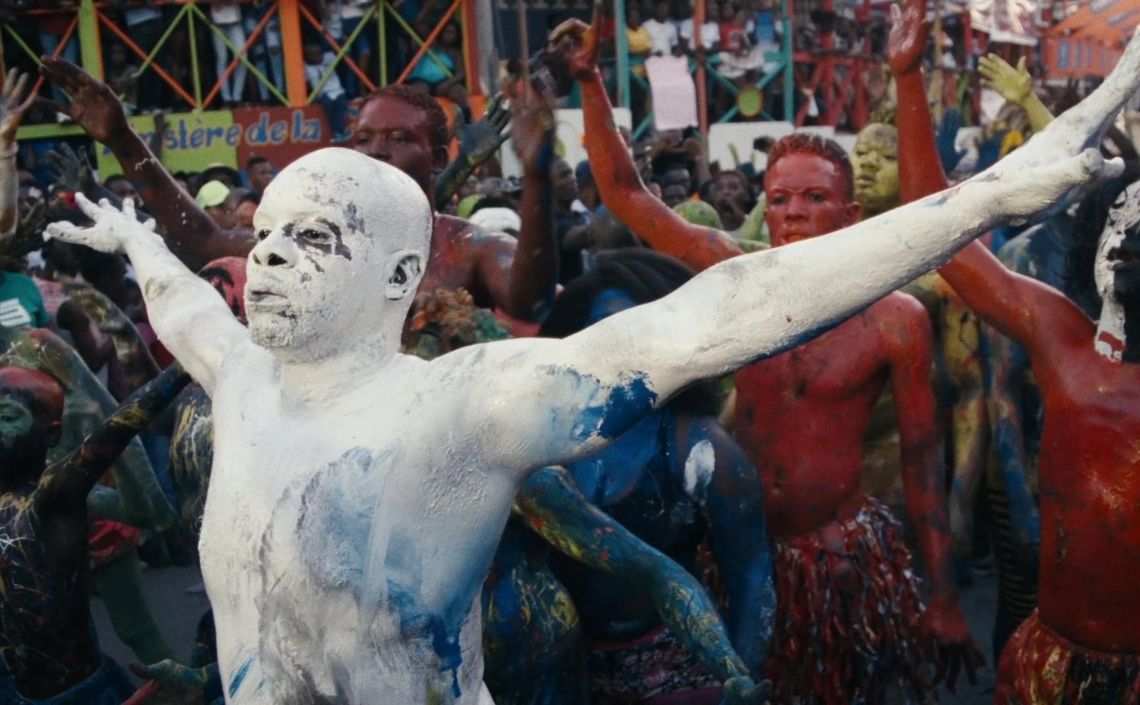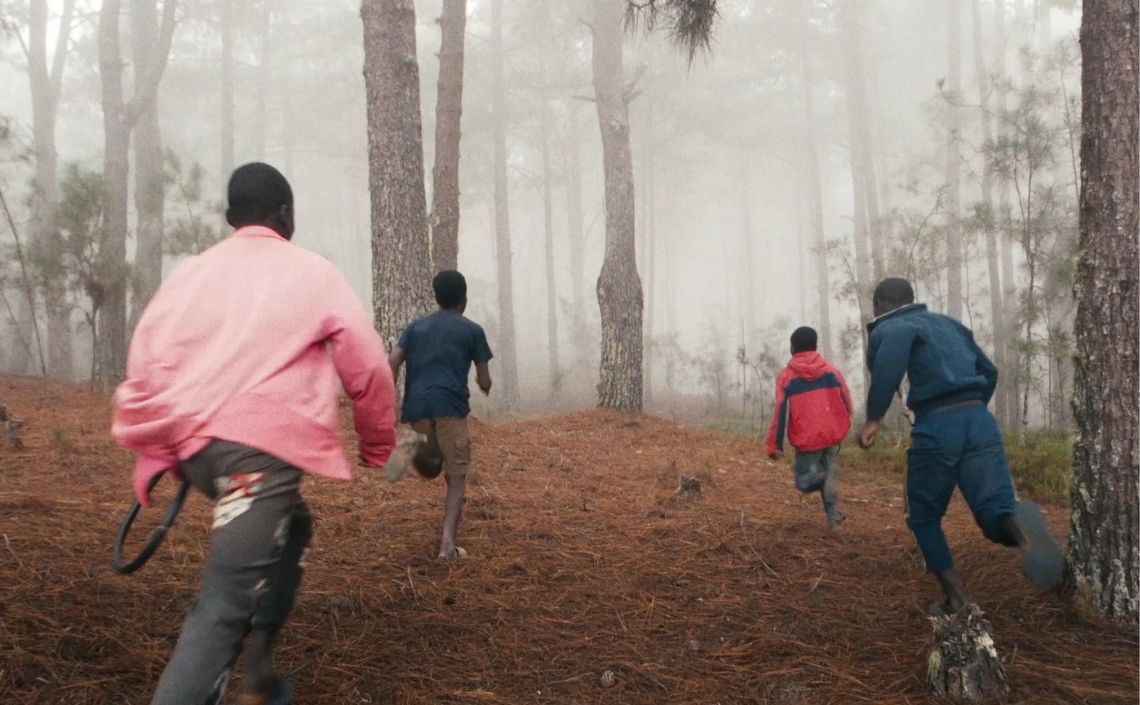Kaveh Nabatian’s Kite Zo A ('Leave the Bones') is an immersive, hypnotic film about rituals in Haiti. It is an audiovisual experience, rather than a documentary depiction - a sensitive, sensual and sensorial homage to the people of Haiti and their culture and resilience. As the film unrolls, we encounter poets, dancers, musicians, fishermen, daredevil rollerbladers, Vodou priests, and a policeman who prepares his colourful makeover for a parade. The narrative glides and glistens and develops an inherent rhythm, guided by the music of Joseph Ray and Lakou Mizik, with the compelling voice-over by the Haitian poet Wood-Jerry Gabriel. We caught up with the film’s director, Iranian-Canadian artist Kaveh Nabatian, who besides making films is also an acknowledged musician, to talk about structuring the film as a remix album, the shooting in Haiti and the ethics of documentary film-making.
- 23-27 OCT 2024
- Manchester, UK
"I’m trying to open the doors of your perception." Kaveh Nabatian about his film Kite Zo A
Interview with Kaveh Nabatian
21 December 2023 by Lucia Udvardyova
Are you in Canada right now?
I'm in New York, editing another film.
What film are you working on now?
I can’t say much about it yet, but it’s a project that I’m collaborating on with Leif Vollebekk, which will be related to his upcoming album. It’s an exciting one, and a new direction for me.
It seems you continue to be tightly connected to the world of music in your film work.
Well, I'm a musician and this film is more of a commission, but I do tend to gravitate towards things that are musical.
Do you think one needs a special kind of sensibility to make films with and about musicians as compared to other kinds of films?
I do. I think that even the way musicians move through the world is very different from the way actors do. So if you're filming musicians and you can understand how they operate, it's a lot easier, because it's a different conception of time, a different conception of the way the art works.
Often when I work with musicians, they're surprised at how long the days are. In music there's a huge amount of time put into learning your instrument. But then the rehearsals themselves are often like two to four or five hours? And a concert is an hour and a half, maybe two hours. But when you're shooting, a day can easily last 12 or 13 hours. Musicians sometimes have a hard time wrapping their heads around that.
And, I guess making films is also a collaborative sort of process.
Yeah, totally, I enjoy trying to apply the rhythm and sensibility of music to film.
That was also obvious from Kite Zo A. The rhythm of the film was very musical, not only because music plays such a big role in the film in terms of content, but also in terms of the film's structure.
Maybe we could talk about the genesis of the film, which basically started as a series of music videos for the album Leave the Bones by Joseph Ray and Lakou Mizik.
Their idea was to do a kind of visual album and so they hired me to do that. It was going to be a bunch of music videos strung together with little bits of documentary-ish stuff. Subsequently, we realised that it was more like it wanted to be its own sort of quasi-music dance documentary with some music video moments in it.
We made a couple of music videos out of the footage. And then the pandemic hit and I suddenly had some time. I knew there was a film on that hard drive, but I just didn't know exactly what it was yet. But with the pandemic, I had time to really get in and try things out and turn it into a film. It took a long way to get there, but in a way it's pretty close to the vision we started out with.
There are various characters and their stories in the film. How did you encounter them?
I had lived in Haiti myself. I taught at the Artist Institute there for a couple of semesters and I was doing lots of projects there, including an experimental film and a narrative film, as well as some commercials and some stuff for UNICEF, etc. So some of the people in the film are my neighbours and friends. Our assistant director, Wood-Jerry Gabriel, was my former student who I've worked with on all of my Haitian projects.
So yeah, it was mostly friends and friends of friends, neighbours. The fisherman/vodou priest is someone who lived a five-minute walk up the hill from my house. Between the four of us - the manager of Lakou Mizik, Joe, myself, and Wood-Jerry, who also narrated and wrote the poetry - we knew what the main cultural touchstones of that area of Haiti were and what we wanted to capture.
For example, we knew that the Marché Carré parade was a big thing that really only existed in that way in Jacmel. And so we found somebody who knew somebody who knew the lady who runs Marché Carré. We'd always hang out first before we brought a camera so we'd get to know people. That's why I think there's a feeling of complicity and engagement. If we just showed up with a big crew of foreigners and were like, okay, we're here to film you, it would not have worked the same way.
We were a very small crew. Often I was doing sound myself. Sometimes I was shooting totally alone, sometimes with Wood-Jerry, and sometimes it'd be the four of us, but it was never big or “professional”. It was the opposite of a union-style documentary kind of thing.
Everything was done intuitively: There's this thing happening over there, let's just go over and shoot it.
You can tell there's a lot of trust from the characters in the film. There's the teacher, or the policeman, shown in their masks during rituals, which feels pretty intimate and personal.
It helped that I spoke Creole pretty well at the time. And the fact that Wood-Jerry was with us. He's a good communicator and obviously a Haitian guy who cares a lot about his culture. So it was clear we weren't there to do some kind of exotification or poverty porn. Part of the reason why I wanted to do the film was because I'd done stuff for some NGOs that were very much like, let's see the suffering of the Haitian people, let's see children crying. And there's something really gross about it. I mean, the intentions behind those things are often good. You need to show the suffering in order to get fundraising from rich American donors. But it reduces the Haitian experience to one of just suffering, which is something I'm not interested in and which wasn't my experience with Haiti at all.
The inner strength of the people in the film is obvious. There is one really compelling scene where a man is reciting a poem about the exploitation and colonisation of Haiti by foreign forces throughout its history.
It's a very strong, resilient culture. The kid who does that poem started going to school at the age of 14, and then he does this poem six years later. I think that on its own is a testament to the kind of strength that exists in that place.
Because in that respect, it is a musical film, but it is also a political film - not explicitly political, of course.
I rarely make things that are overtly political, but there is definitely a political aspect to a film like this. I guess, in a non-cerebral way, I’m trying to open the doors of your perception. And then when something political occurs on screen, it's a lot easier to take than if you're constantly being hit with historical facts and someone telling you what you should think.
How did you incorporate music into Kite Zo A? There's the album, Leave the Bones by Joseph Ray and Lakou Mizik, which acted as a precursor of the film.
The album actually wasn't finished when we were working on the film. So the music shifted over time. But when we were working with choreographers, they had versions of the songs, so they were choreographing directly to the music. But even then, I think, part of what makes the film pretty immersive is that we were working with stems.
Luckily I was close enough with Joe and the band that I could get the stems or even rerecord parts to make it really work best with the visuals because on the album there's often an intro, and then there's this big four on the floor kick drum that comes in. But in the film, if I just did that over and over it would be powerful for like 10 seconds and then it would just lose its energy. So it became a lot about, okay, when does the kick drum come in? When does the hi-hat come in? So it's not just like a chunk of music on top of a chunk of images, but it’s about making them woven together. That was really fun. And then in the mix, we were able to really get into details of where and why things come in and how to make that work with the images. The mixer is a drummer himself. And so in some places in the mix, we were moving drum patterns around a little bit to line up better with the images. It's like we're kind of remixing a remix album.
That's probably where your musical background comes in - the sensibility towards music, and its dynamics and structure. Quite often, music plays a secondary role in films, and it tends to be suggestively placed. How you work with music in film is almost like producing a track.
And I think for some people who might not have a close connection with music, it can be a little bit scary. Because I'm a musician, I was able to think about the images almost in musical terms and to work more intuitively and musically rather than have a scene and be like, okay, I need to make the scene more sad or more happy so let's put a happy or sad piece of music on. I think a lot about how to make images and music work together and where to cut.
It's important for me that it doesn't become rhythmically too repetitive. I like to think of images as a melody over the rhythm. As with a melody in a piece of music, sometimes you hit it on the one, but a lot of the time you're floating over it and being rhythmic in a non-predictable way.
There's also this dreamy, ethereal atmosphere emanating from the visuals. And there was Wood-Jerry Gabriel, whose poems feature throughout the film.
Yeah, that became kind of like the backbone of the whole film in a way.
We worked together when we were shooting, and then I started editing. I knew there was all this nice footage but it just wasn't sticking together. And so I talked to Wood-Jerry about it, and he said he'd try to write some poetry. What ended up happening over the course of maybe six months is that he would send me something, I would cut to it, tell him what I thought was working and what wasn't, send him the images with his poetry over it, and he'd rewrite the poetry, and then he'd send it over, and then I'd recut this to the new poetry, and it kind of went back and forth like that until we got to somewhere that we felt that we were happy with.
I think the poetry is not prescriptive. It becomes the backbone of the whole film, but it's not telling you what to think. It provides this layer that makes you feel comfortable - there's something going on here, even if I don't understand every image that he's talking about, his voice is so soothing. It feels safe. So it lets you open up to the music.
Yeah, definitely. Was there something that you shot and then decided not to include? In terms of an ethical aspect of the shooting, let's say.
We didn't want to paint a totally rosy picture of what's happening in Haiti. It is a very challenging place. So we wanted to make sure to show some of the challenges. You can make all the rules you want about ethics and documentary filmmaking, but at the end of the day, I think when you're shooting, if it feels weird, it is weird. There were times when I was like, Oh, this is really pretty, or this is really emotional, but something doesn't feel right about it. And so either I'd stop shooting, or at least I wouldn't use it in the edit. And it's hard to know exactly what it is. Is it because it feels exploitative? Is it because it's exotifying? I don't know or really care. I think that the most important thing for me is that if you spend enough time in a certain place, you start to get a compass for what's authentic to that place and what isn't and you learn to trust your intuition.
It's more like a gut feeling I guess.
Yeah. And I mean, those people are my friends. And so it's kind of like, how would I want to be portrayed or presented? I think sometimes with documentaries it's easy to “other” people, to film people who are different and to not really empathise with what their situation is.
Is it possible to film if you are so removed from what you're filming? To shoot in an unattached way, as an outsider who remains emotionally distant towards its subject?
I think I have done it at certain times. This is a good question, actually, because it's exactly what I was trying to avoid with this film. When I was working for some of these NGOs, I was looking at people not as people exactly, but as barometers of suffering, which could yield emotional results that would yield funding for the NGO. It was almost like I had to in order to get the material that I needed for these organisations. And I hated it. I hated how I felt, and I've since stopped doing stuff like that.
I think we in the West see these images all the time. I remember there was one famous photographer who came to Haiti and – let’s be honest – Haiti's always been in challenging situations, but it wasn't nearly as bad at the time as it is now. He'd get really good, really emotional photos. I remember at one point we were walking down the road and there was a UN SUV with a cracked window, like from a rock or something, but it was a totally peaceful day, the sun was out, and people were playing. He went and put his camera inside the car to shoot through the cracked window to make it look dark and intense. But that's not the situation any of us were living in at that moment, but he knew that that was going to get an emotional resonance in the media. The guy's super talented and he travels the world, but it felt a little disingenuous to me.
I guess it's in a way about them and their ambitions.
You need to get your Pulitzer Prize and you've got to get the content that The New York Times is going to pay you for. So, you know, if he just takes a picture of kids having fun on a nice sunny day, it is not going to sell.





